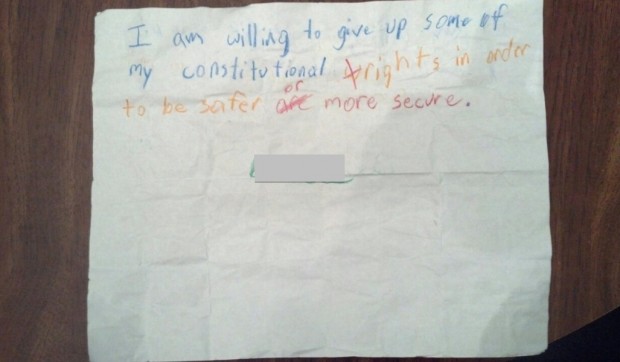This week, left-wing outlets, like NPR’s quiz show, Wait, Wait . . . Don’t Tell Me!and the Huffington Post, as well as the British Telegraph, expressed surprise and concern that the new national Common Core standards will destroy the love of literature. The leftist outlets focused on favorites like Catcher in the Rye and To Kill a Mockingbird, but couldn’t seem to connect this unconstitutional federalization of education with their favorite presidential candidate.
They should also be concerned about what the recently released test questions reveal about what the feds want: happy workers for the State.
The test questions, which will eventually be given to every single student, are the kind you could expect from a close pal of Bill Ayers, co-founder of the terrorist group Weatherman-turned-“Distinguished Professor of Education.” Ayers’s close colleague, Stanford Education Professor Linda Darling-Hammond, education director of Obama’s presidential transition team, heads content specifications for testing under one of the consortia, Smarter Balanced Assessment Consortium which received $176 million in stimulus funds to develop testing under Common Core—now the law of the land, at least in 46 states. (The rest of the $360 million for testing was given to PARCC, Partnership for Assessment Readiness for College and Career.)
SBAC recently released 16 sample test questions. They reveal that the “transformation” of American education that Darling-Hammond had eagerly anticipated will be fulfilled—toward making students into global citizens, devoid of a sense of cultural heritage, and content with performing quick tasks that require little concentration.
Common Core was sold as delivering more academic rigor, on a more consistent state-to-state basis. But one of its most controversial aspects for the English/Language Arts portion (the other being math) was the replacement of literary works with “informational texts.” Students are to divide their time equally between literature and informational texts, until high school, when literary works will make up only 30 percent of English/Language Arts instruction.
The recently released sample test questions do indeed test for students’ ability to search out information from both written and audio/video “texts,” and provide short written responses to them, as well as, occasionally, correct punctuation.
The Common Core website attempts to assure us that “the Standards require a certain critical content for all students including classic myths and stories from around the world, America’s Founding Documents, foundational American literature, and Shakespeare.” Yet, at the same time, “they intentionally do not offer a reading list.” We know, however, that if students are to be tested on reading and writing skills, some content will be necessary. The content presented in the sample test questions is telling. None of it is from the “classic myths and stories,” etc., cited above.
Common Core proponents repeatedly refer to the changed “twenty-first century workplace.” Accordingly, tests are administered by computer and incorporate videos. Two of the samples ask students to answer questions after watching short videos about weightlessness in space. Such testing is in line with the increased emphasis on “listening and discussion skills” that I noted in my report for Accuracy in Media. In Common Core-aligned lessons, high school juniors and seniors were tasked with looking at, and then discussing, photographs and videos.
The trend of late has been to emphasize such “alternative literacies,” but Common Core codifies what are really preliterate skills.
Even the written texts and analytical tasks seem to test only for rudimentary skills: the ability to read a short, simple passage and then pull out the correct information. Three of the sample questions involve searching out answers and definitions in a simple narrative titled “Grandma Ruth.”
Another question asks the students to provide an ending to a story that consists of two short paragraphs about a character named Jeff and his dog walking by a lake, when a splash is heard.
The question remains: how would the response be graded? For absence of grammatical errors? Or according to Darling-Hammond’s criteria spelled out in her 2009 Harvard Educational Review article of “developing creativity, critical thinking skills, and the capacity to innovate”? She did indicate that new assessments would use “multiple measures of learning and performance.” We can expect some—ahem–“discretion” in grading.
The intent of Common Core is to ensure every student of “college and career readiness.” Are such questions intended to meet the top goal of Darling-Hammond and the Department of Education—that is to “close the achievement gap”? One suspects so.
The next question too asks the student to complete a writing assignment–arguing for a longer school day. This time the student is given a schedule of activities. The assignment is to “revise the paragraph by adding details from the daily schedule that help support the reasons for having a longer school day.” Presumably, this tests for the ability to provide “relevant evidence.”
Coincidentally, the idea of public schools being “centers of community life” with longer days has been something that the Obama administration has been promoting with daily announcements about “cradle to career” initiatives and efforts to “engage” various “communities.” While he was still head of Chicago schools, Secretary of Education Arne Duncan made schools community centers, offering three meals a day, and even eye exams and eyeglasses. Now he wants to expand the role of schools on a nationwide basis. In Duncan’s vision, schools would be open 12 to 13 hours a day, 7 days a week; they would “meet the social and emotional needs” of students, and provide cultural and academic activities, as well as services for parents, like GED tutoring and healthcare clinics. To Duncan, such efforts are part of a “battle for social justice.”
So is it a coincidence that one of the test questions concerns a longer school day?
Notice the student is not asked if the school day should be longer. Textbooks, similarly, now ask students to write papers on how “you personally might respond to [President Obama’s] call to remake this world.” The popular Norton Reader does exactly this in one of the topic questions that follows Obama’s 2009 Cairo speech in its pages.
Next in the sample test is a reading passage titled “Planes on the Brain,” by free-lance writer Elisabeth Deffner in a children’s magazine called Faces,published by Carus Publishing, which was acquired by ePals Corporation in 2011.
ePals, which is working with Microsoft, Dell, and IBM, encourages “global collaboration.” One of its “Rich, Multi-Disciplinary Student-Centric Learning Centers” is called Global Citizens. Its website says, “Microsoft and ePals are working together to offer schools and districts interoperable products and tools for building educational communities, delivering high quality content and facilitating collaboration.” The Bill Gates company, Microsoft, is the vehicle of delivery for content. The Bill and Melinda Gates Foundation is the largest private funder of Common Core. To get schools “tech ready” for the online national testing, the Gates Foundation-supported Education Week provides helpful tips and reminders and an encouraging blog post. Not surprisingly, a test question comes from an article published in an online magazine that partners with Microsoft.
These are close collaborators indeed, for the “Our Approach” page of ePals could have been written by Darling-Hammond herself:
Authentic ePals projects are centered around meaningful content and experiences that require teamwork, digital literacy skills, higher-level thinking and communication. By engaging in authentic learning experiences about relevant issues, students, teachers and mentors learn and work together, strengthening core learning while motivating learners and building self-confidence and skills necessary for future careers.
ePals, also, we are told, helps teachers learn “to use technology effectively in their classrooms, by providing professional development, curriculum, contests and other resources.” The “Transforming Volunteering” promotional video features a quotation by—surprise–President Obama about “shaping the future.”
In 2010, ePals received broadband stimulus funds and won the contract for New York City. Partners listed on the video include the World Bank, National Geographic (which just announced a line of Common Core-aligned reading materials), and the Washington Post. ePals is also partnering with Teaching Matters, which describes itself as “a non-profit organization that partners with educators to ensure that all students can succeed in the digital age.”
Teaching Matters, on October 18, 2011, honored Darling-Hammond as a “Champion of Education and Innovation.” The press release referred to Darling-Hammond as “an authority on school reform, educational equity and teacher quality,” and noted that in 2007, Education Week (the Gates-supported Common Core advocacy newsletter) “named her one of the 10 most influential people in the field of education over the last decade.”
The “Champion of Education and Innovation” promises to influence further with such test questions:
• How was the Tuskegee Airmen program a positive influence? (along with a “highlighting” exercise) (Nothing wrong with learning about the Tuskegee Airmen—except when such examples are used in isolation to indict the U.S. as a racist/imperialist nation.)
• A writing assignment concerning the use of cell phones in schools with reasons for and against presented in bullet points (must be one of those “relevant” topics).
• A passage, “Diamonds in the Sky,” about astronomy with two multiple choice questions and a short writing response regarding how scientists can use the knowledge to make diamonds.
• A passage about the invasion of kudzu that asks the student to eliminate unnecessary sentences.
• Grammatical corrections to a student essay about watching a hockey game.
There are no references to the “classic myths and stories” or “America’s Founding Documents” that bureaucrats promised.
Are these examples of the “higher order thinking” and “more thoughtful assessments” that Darling-Hammond touted in her post-award interview by Teaching Matters Executive Director Lynne Guastaferro?
Apparently “twenty-first century skills” and “higher order thinking” don’t call for lengthy works of literature, like Shakespeare’s plays, Little House on the Prairie, or even favorite novels of liberals. More likely, students will be given a short passage and asked how a sod house affects the ecosystem. The wallpaper for the Teaching Matters website features a bulletin board with projects on biodiversity. The U.S. Environmental Protection Agency is advancing the use of their materials regarding environmental regulations for Common Core. California’s Invasive Plant Inventory is on the recommended informational reading list, as is EPA Executive Order 13423.
Do “twenty-first century” students no longer need to read poems by John Donne about love so strong that separations are like “like gold to aery thinness beat”? Or do they need to learn how to make diamonds? Are we really going to inspire the next great American novelist by asking him to insert a few sentences on a computer screen about what happens when a splash is heard?
For sure, for decades now, educators have been moving in the direction of Common Core, with the replacement of classic imaginative works by texts that address “relevant” leftist political issues. Since at least the 1980s those like E.D. Hirsch have been decrying the loss of cultural cohesion through an unraveling curriculum and lowering of standards.
Many gave up on the public school system and sent their children to private schools or home-schooled them. But critics warn that national tests will make these curricula moot. They are right. Education Week recently reported that already many Catholic and other private schools are jumping ahead and adopting Common Core in preparation for college-entrance exams that will line up with Common Core criteria.
Literary works promote an American cultural identity, pass on Western Judeo-Christian values, inspire independent thought, and develop the imagination. Their elimination is likely to produce citizens incapable of understanding the proper–and limited–role of the state. It’s too bad that the liberal lovers of literature failed to see the dictatorial move of a president through the Department of Education in his first term. Now they whine about students not reading To Kill a Mockingbird. They themselves need to read Dr. Zhivago.






 (breitbart.com) Their move will allow custodians to undertake training and carry handguns on the K-12 school grounds in Williams county.
(breitbart.com) Their move will allow custodians to undertake training and carry handguns on the K-12 school grounds in Williams county.